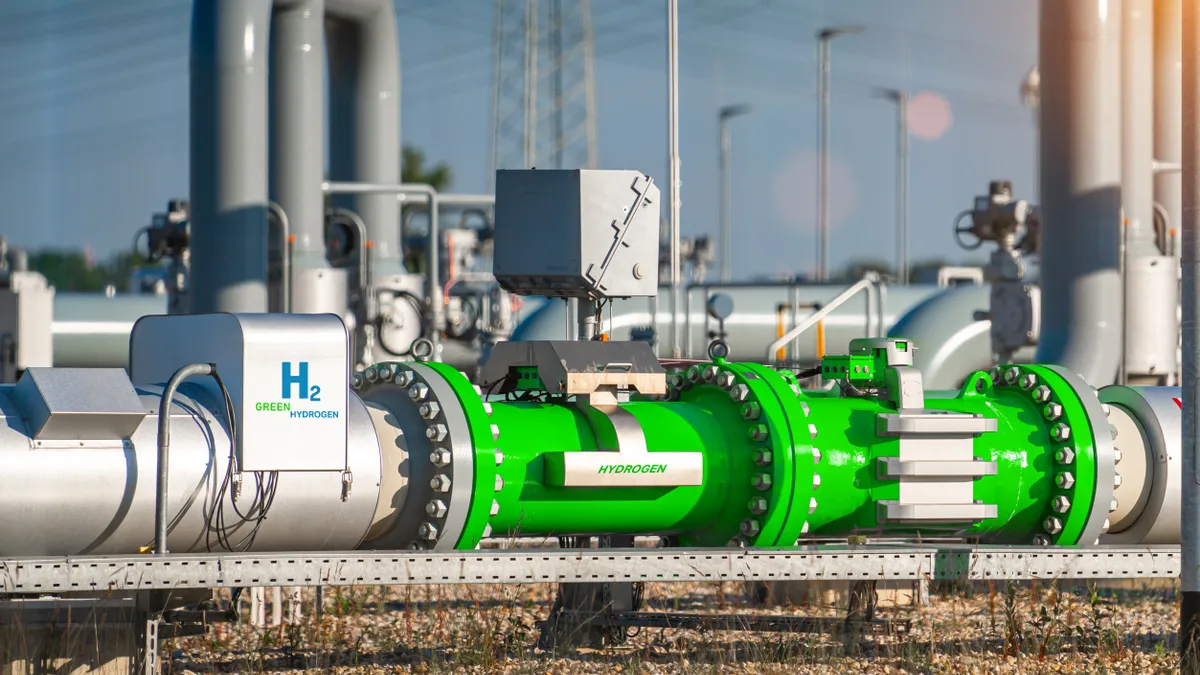Dive Brief:
- The U.S. Department of Energy on Monday released a plan to boost hydrogen production, targeting high-impact uses, reducing its cost and focusing on regional networks.
- The National Clean Hydrogen Strategy and Road Map examines future “demand scenarios,” such as domestic production of 10 million metric tons of clean hydrogen annually by 2030, 20 MMT a year by 2040 and 50 MMT annually by 2050.
- The plan follows the 2021 Infrastructure Investment and Jobs Act that required a “technologically and economically feasible national strategy and roadmap to facilitate widescale production, processing, delivery, storage and use of clean hydrogen.”
Dive Insight:
Secretary of Energy Jennifer M. Granholm said DOE worked with federal partners to develop the road map as a guide to government and industry to “realize the full potential of this incredibly versatile energy resource.”
The road map says targeting strategic, high-impact applications will ensure clean hydrogen will be used in “highest value applications” in markets such as the industrial sector — chemicals, steel and refining — heavy-duty transportation and long-duration energy storage.
Addressing material and supply chain shortages and designing for efficiency, durability and recyclability, with investments in energy storage and distribution, hydrogen initiatives can reduce the costs of production and delivery of clean energy, DOE said.
The plan calls for a focus on regional networks such as hydrogen hubs that will enable large-scale clean hydrogen production close to high priority hydrogen users and allow a critical mass of infrastructure to be shared.
Federal agencies will collaborate with industry; universities and colleges; national laboratories; local and tribal communities; energy, environmental and justice communities;labor unions; and other stakeholder groups.
Sectors such as chemicals manufacturing, steel production, heavy duty transportation and liquid fuels production are difficult to decarbonize with traditional approaches, DOE said. They are expected to become priority markets for clean hydrogen.
Hydrogen also is seen as enabling renewables using long-duration energy storage and offering flexibility and revenue streams to clean power generation such as the nuclear fleet and advanced nuclear reactors and other new technologies, according to the report.
The Inflation Reduction Act provides a Hydrogen Production Tax Credit to incentivize the production of clean hydrogen in the U.S.
The IRA also promotes demand for hydrogen with grants and loans for car manufacturing, including fuel cell electric vehicles and for industrial demonstration projects.
Loans also are available to help retool, repower, repurpose or replace energy infrastructure, DOE said.
An analysis by Energy Innovation in April said research shows “loose” Treasury Department guidance of the IRA could “create tens to hundreds of millions of tons” of greenhouse gas emissions annually at a cost of $30 billion annually in federal funding “while setting the clean hydrogen industry up for failure.”
The report said the leading technology pathway for producing hydrogen at low lifecycle greenhouse gas emissions rates is electrolysis, which uses electricity to split water atoms into hydrogen and oxygen.
DOE last September issued an industrial decarbonization road map, proposing a strategy to reduce emissions associated with chemical manufacturing, petroleum refining, iron and steel, cement production and the food and beverage industry.
In March the agency issued reports charting pathways to commercialize long-duration storage, advanced nuclear reactors and clean hydrogen. The Pathways to Commercial Liftoff reports are intended to help industry, investors and stakeholders make decisions about emerging technologies needed to cut the power sector’s greenhouse gas emissions.















